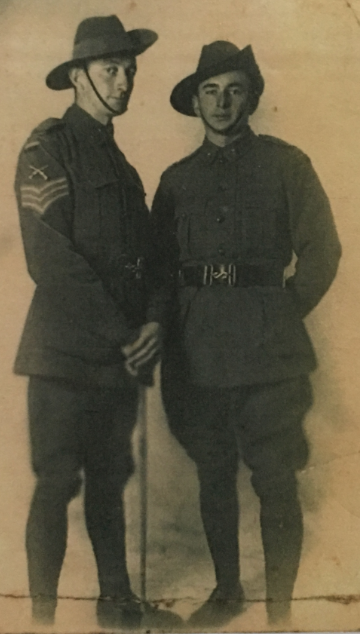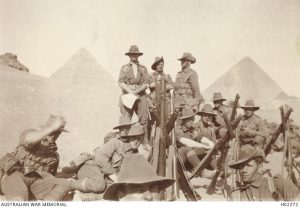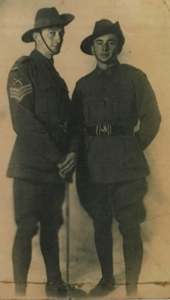
Sergeant John ‘Jack’ Curran (right) with Sergeant Harry Conroy Thacker. Image courtesy Joan and Kel Regan.
John Curran, or “Jack” to all that knew him, was working on the labour gangs constructing the railway at Kendall, New South Wales when he heard call to arms. Australia was at war! He enlisted at Randwick on 23 August 1914, less than a month after the declaration of war and more than likely as soon as news had filtered up to his work gang at Kendall.
Jack was born in Copeland, New South Wales, on 23 November 1892. He was raised by his grandmother Helen Curran (nee Robertson) but spent a considerable amount of time at Adare, Euchareena, where his Aunt Sarah lived with her husband, Cornelius Driscoll, and their seven children. Jack’s war service is well documented in a series of letters he wrote to his cousins Nell and Bess and his Aunt Sarah during his time in Army. In his letters, Jack fondly remembers his time at Adare, the folk he met and those with whom he worked.
Army life agreed with Jack. He slotted easily into the training routine, ever eager to go overseas and engage the Hun. However, he was to remain at Randwick long enough to grow bored and restless. The grasses of Kensington racecourse became dust bowls as the military trained, causing Jack endless problems with keeping his tent, rifle and other equipment clean.
…Every blade of grass is nearly worn off the racecourse and it is dirty and sandy. Everything gets dirty in no time, and it takes a great deal of time to keep the rifles and tents in order…
On 9 November 1914, a postcard arrived at Adare bearing an image of TTS Suffolk. After several false starts (much to his disappointment) Jack left Sydney on the 14th October and set sail for Albany, Western Australia. “Banjo” Paterson, one of the war correspondents travelling with the fleet, in his article in the Sydney Morning Herald of Tuesday, 8 December 1914, tells of the ships arriving at Albany in twos and threes and waiting, anchored, just outside the harbour until the fleet had assembled and then slowly weighing anchor and “a great string of ships” setting off in silence into the Unknown.
…There are about 40 altogether, including the New Zealanders. We leave when they are all here. There are a good few warships going with us for protection…
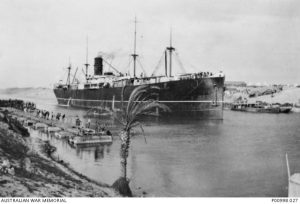
The troop transport ship SS Suffolk, on which Jack sailed to the front. Image courtesy Australian War Memorial.
Jack expected to go to England for further training before entering the war zone in Europe but, as he explained in a letter, he ended up in Egypt “owing to Turkey siding with Germany and declaring war”. Two hundred thousand troops were stationed in Egypt along the Suez Canal. Jack addressed his letters from “Mena Camp, The Pyramids Egypt”. He was in awe of the size of the pyramids, the desert and the area in general but again he was plagued with the problem of cleanliness. His unit was camped on the edge of the Great Sahara Desert on raw brown sand. It was, according to Jack, “clean sand”. The days were hot and the nights cold. They marched, drilled and paraded. Jack grew bored.
…In fact, we would welcome a diversion of that [combat] kind, it would kill the monotony of camp life and provide a bit of excitement…
Christmas came and went and despite rumours to the contrary Australian Forces remained in Egypt. Jack was admitted to the Military Hospital suffering from measles and pneumonia and then a second attack of measles. It took him nearly two months to recover, by then it was March. His letters were filled with descriptions of Egypt and the pyramids.
On 5 April 1915, Jack, along with other members of the 1st Infantry Brigade AIF embarked on Derfflinger as part of the Mediterranean Expeditionary Force Gallipoli Campaign. They formed part of the second and third waves of the attack on the Gallipoli Peninsula. On 14 June Jack writes:
[Jack had met Tom Hammond when enlisting at Kensington and the pair became firm friends. Tom received his shrapnel injuries on 11 June and was transferred to a Military Hospital at Malta. His leg was amputated and he died on 24 July 1915.]…I am quite well and trust that this finds you all the same at Adare. Tom Hammond got wounded the other day in 3 places in the thigh with shrapnel. I get a Turk occasionally. It is wonderful how bloodthirsty one becomes after a bit of fighting. Men are shot just the same as if they were rabbits or dingoes…
The occasional card or short letter still reached Adare from Gallipoli. Jack felt himself to be extremely lucky and still “moving on three meals a day”. It was hot and the flies were bad. He longed for the weather at Adare. He felt constrained in what he could write. Censor markings appear in the corners of his letters. He signed his letters “Good bye and good luck” instead of “Yours Jack”. The war engulfed him.
…The artillery has started firing. The Turks are sending over high explosive shells, trying to hit our guns in the rear. The shells are just going a few feet over our trench with a venomous kind of swish and bursting 150 yards in the rear. Our guns are replying and with all the noise I can hardly collect my scattered wits…
…The big shells weigh anything from 200 pounds upwards and when they start flying about knocking things out of shape they always create an uneasy feeling especially if they hit within 30 or 40 yards of anyone. They can be seen coming for a long way off and heard too. They make a noise like a very big tree falling when they are coming through the air and when they hit the ground it is like as if a volcano burst out. The shell bursts up into pieces half as big as a good-sized plate and it is 2 or 3 times as thick, so if a piece hits anyone there is not much hope of recovering from it…
Jack formed part of the Lone Pine offensive at the beginning of August. He mentions, when back in Egypt, of having photographs taken and sent to Adare where he was wearing a red fez and an “old tunic I picked up after the memorable battle of Lone Pine”.
On 6 August 1915, while on Gallipoli, Jack was promoted to Corporal.
Respite from the endless sights and sounds of war came when his battalion was sent back to Lemnos in September of that year to recuperate. In his letter dated 12 September he mentions being a “bit off colour”, the wound in his leg troubling him and his arms being “crook”. It was obvious that five months of fighting on the Peninsula had taken its toll on his health.
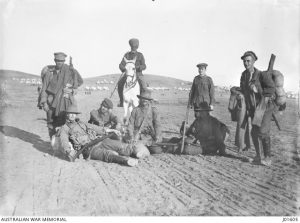
Australian soldiers newly arrived from Gallipoli, escorted by an Indian soldier on horseback, with all their kit, ready to enter rest camp on Lemnos Island, Albert W Savage, 1915. Image courtesy Australian War Memorial.
Jack left Lemnos two months later and returned to Gallipoli via the troopship Osmanick. The heat of summer was replaced by the bitter cold and wet of winter. It rained most days, the trenches flooded, the sides gave way under the weight of the water. Jack took consolation in the fact that life was just as bad for the Turks in the next gully some 150 yards away.
On 28 November 1915, while still at Gallipoli, Jack was promoted to Sergeant.
Jack was one of the last to be evacuated from Gallipoli. He described it in detail in his letter dated 26 December 1915:
[Lieutenant Cotton and Corporal Winterbottom both died in France on 24 July 1916.]…For over a week stores, ammunition, guns and troops were being sent away every night. The troops in the firing line left in 2 nights. The second night the men left were divided into 3 parties. In “B Coy”, “A” Party 1 officer 5x men, “B” party 8 men, “C” party No 1, 1 officer 10 men, and “C” party No 2, 1 Officer 2 men. was one of the last party. Lieut Cotton, myself and a corporal named Winterbottom were the last to leave B Company’s line. From where we were it was about 2 miles to the pier where we embarked. A boat was waiting and we only had to get on board. Shortly after we got on board the Turks opened up a heavy rifle fire all along the line they must have been puzzled by the silence in our lines. We have had a lot of silent stunts lately so I suppose they were not alarmed much. The firing soon stopped…
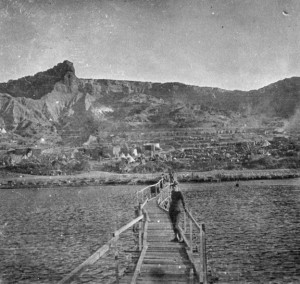
A view of Anzac on the last day of occupation, 19 December 1915. Image courtesy Australian War Memorial.
The 1st Battalion returned to Egypt via Huntsgreen alias Derfflinger and it was here that Jack lost contact with his battalion due to being hospitalised with a bout of the mumps.
On a personal level, Jack lamented the lack of mail and news from Home.
…You hardly do yourself justice in your letters. Even things which you over there consider trivial are interesting to us in away because it is the little things that tell, especially when on active service. Bullets are very small things but they play a mighty big part in a man’s life if he happens to get in their way. Things that occur every day in your life interest us because they help us to remember you people all the better and imagine how you are all getting on…
Jack’s mail had followed his battalion to France while he was in hospital. He often contemplated an eventual end to the war and toyed with the idea of joining one of the escorts back to Australia for a short holiday. Determinedly he remained in Egypt; his belief that every man should do his duty was stronger than his desire to return home.
For the next six months Jack worked as part of the Administration team at Ghezireh and then was taken on strength to the 1st Training Battalion at Tel-el-Kebir in Egypt. He mentions being the permanent line sergeant for 1st Brigade “B” Class at the Base. He obviously enjoyed the hustle and bustle of camp life and of co-ordinating the comings and goings of the various troops
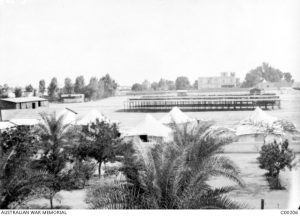
Near Headquarters at Tel el Kebir camp, between Cairo and the Suez Canal, May 1916. The camp here was established for personnel of the First Anzac Corps after they were evacuated from the Gallipoli Peninsula. Image courtesy Australian War Memorial.
On 10 June 1916 Jack wrote from Perham Downs Camp, England:
…Just a line to let you know that I am safe and sound in England. All the country is beautiful and green. It is like getting a glimpse of Paradise after the Egyptian deserts…
Since the main theatre of the War had now moved to France, it was appropriate that the AIF set up camps in England to co-ordinate the training of new recruits and provide hospitals for the sick, wounded and convalescing. Perham Downs on the Salisbury Plains was the base of the 1st Division. Life was active, besides his normal duties Jack had football and cricket to occupy his spare time. He took trips to London on leave and lived in anticipation of sighting a zeppelin during one of their raids. By October his missing letters began to trickle through and he was delighted.
In October Jack spent three weeks at the School of Musketry at Tidworth where he was trained on the use of the Lewis Gun.
On 13 December 1916, he was taken on strength to France via the Arundel where he joined the 2nd Battalion. In France, he had another couple of stints in hospital due to scabies and rejoined his unit on 16 February 1917.
Jack’s last letter was written on 18 March 1917. He marks it as “with Unit in France”.
My Dear Nellie
Just a line to let you know all’s well, and one is very fortunate in being able to say this in these days of lash on a large scale out here. At least the Huns seem to be yielding to our pressure and getting back home again and everyone is looking forward to the end of the business when we can all get back again and to use the old saying “cultivate the arts of peace”. This retirement has put great heart into the boys and when we come in contact again I am sure that the Huns will feel the full power of our punch once more and I hope it will be a knock out, and la guerre fini (the war is over). I think it will feel strange again when war is mafeesh (no more), and people cease from killing one another, the atmosphere will be too tame and quiet, especially for those who have been engaged in the business for some time. ……….. I don’t mind mixing things with the Huns / when a chap knows what to do but writing letters is quite another matter ……. However, victory looms large on the horizon, and we are going to win in a very short time if possible. But what the future holds of course no one can say but we must look on the bright side of things and prepare for the worst. Trusting you are all ok at Adare …..Yours Jack xxxx
More than 60,000 young Australian men died during the First World War; 7,482 died in the Second Battle of Bullecourt alone.
Sergeant Major John Curran, SN387, 2nd Battalion 1st AIF, or “Jack” to all those who knew him, died as he had lived: fighting for The Cause he believed in. On 7 May 1917 he was in a front-line trench at Hermes, France, when a shell exploded sending a piece of shrapnel through his helmet and into his head above his eye. Eleven reports were gathered by the Red Cross from different soldiers who saw him wounded or directly after. Some say he died instantly, others say he died hours later at the nearby dressing station. They all agreed he was “a good soldier” and “one of the finest lads in the Company”. As one soldier said “he was a very popular man and did not know what fear was”.
There is no marked grave for Jack, he is remembered on the Villiers-Bretonneux Memorial in Northern France, the Roll of Honour in Gloucester Historical Museum and panel number 32 on the Roll of Honour at the Australian War Memorial in Canberra.
In April 2016 Jarvis Regan, a relative of Jack Curran, travelled to the Villers-Bretonneux Memorial in France. Jarvis laid a quartz stone from Adare in memory of Jack. The stone is inscribed:
To Jack Curran from Adare station. Euchareena, NSW, Australia
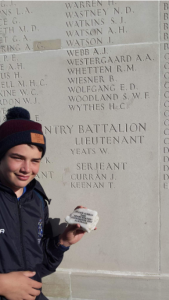
Jarvis Regan with his tribute to Jack Curran, Villers-Bretonneux Memorial, France, April 2016. Image courtesy Joan and Kel Regan.
* Sharon Jameson 2017

